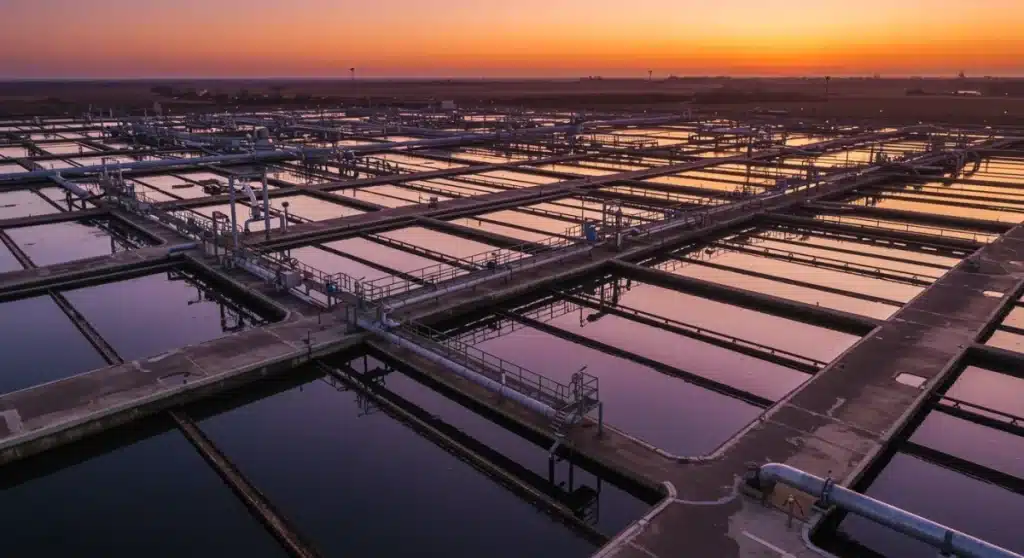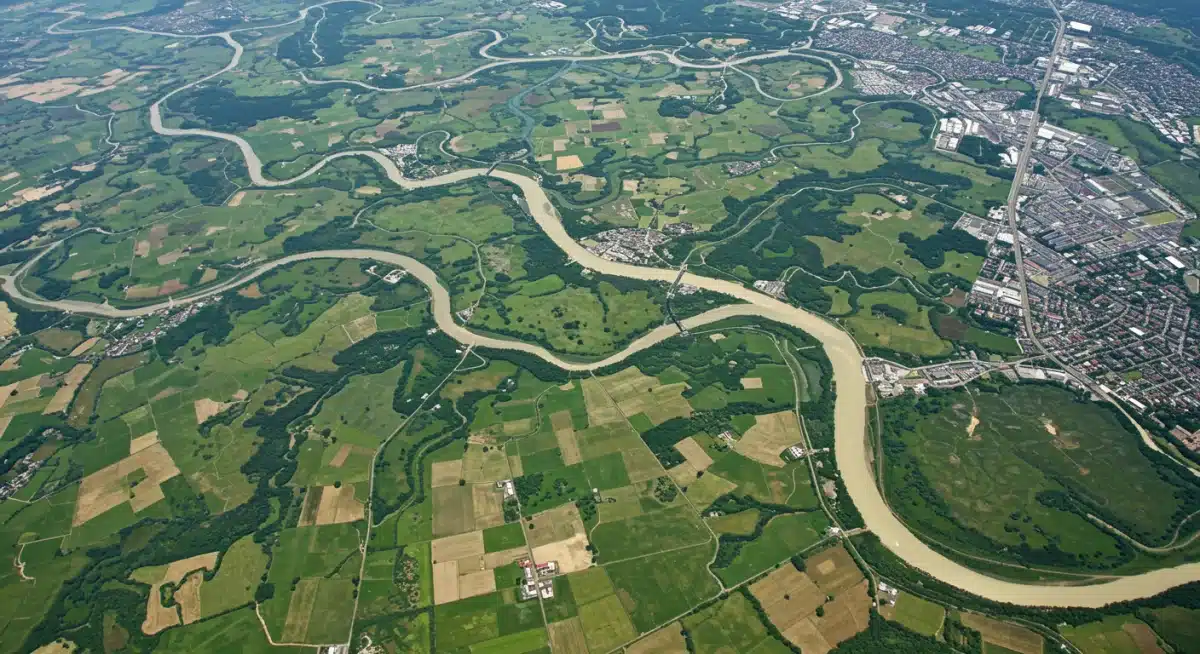U.S. Water Policy 2025: Challenges & Industry Opportunities

Recent updates to US water policy for 2025 are reshaping industry landscapes, presenting both significant challenges and new opportunities for companies involved in water management, infrastructure, and sustainable practices.
As of late 2024, significant shifts in US Water Policy 2025 are unfolding, presenting critical challenges and unique opportunities for various industries. These recent updates, driven by escalating environmental concerns and infrastructure demands, mandate immediate attention and strategic adjustments across the sector.
Understanding the Evolving Regulatory Landscape
The regulatory environment governing water resources in the United States is currently undergoing a rapid transformation. Federal agencies are implementing new directives that aim to address long-standing issues such as water scarcity, pollution, and aging infrastructure, with a clear focus on resilience and sustainability for 2025 and beyond.
These changes are not merely incremental; they represent a fundamental rethinking of how water is managed, protected, and utilized by industries nationwide. New legislation and agency guidance are shaping compliance requirements and investment priorities.
Key Legislative and Agency Actions
Several pivotal actions are defining this evolving landscape. The Environmental Protection Agency (EPA) recently unveiled revised guidelines concerning PFAS (per- and polyfluoroalkyl substances) contamination, impacting water utilities and industrial dischargers directly. These guidelines, effective January 1, 2025, set lower permissible limits, necessitating advanced treatment technologies.
- PFAS Regulations: Stricter limits on ‘forever chemicals’ in drinking water.
- Infrastructure Funding: Billions allocated for water infrastructure upgrades through federal programs.
- Waters of the U.S. (WOTUS) Rule: Ongoing legal challenges and potential further revisions impacting wetland protections.
Impact on Industrial Operations
Industries reliant on water for manufacturing, agriculture, and energy production face immediate operational adjustments. Compliance with new discharge permits and water quality standards will require substantial investment in new technologies and process optimizations. Companies must adapt to these shifting goalposts to avoid penalties and maintain operational licenses, thereby influencing their strategic planning for the upcoming year.
Major Challenges Facing Industries in 2025
The impending policy changes bring a host of significant challenges for various industries. These challenges span from increased operational costs to complex compliance requirements and the urgent need for technological adoption, all within a tight timeframe as 2025 approaches.
Industries must navigate intricate legal frameworks and often conflicting state-level regulations while simultaneously contending with the physical realities of climate change, which exacerbates water stress in many regions. The confluence of these factors creates a demanding operational environment.
Rising Compliance Costs and Investment Needs
One of the most immediate challenges is the financial burden associated with meeting new regulatory standards. Upgrading existing infrastructure, implementing advanced water treatment systems, and enhancing monitoring capabilities all require considerable capital expenditure. For example, municipalities and industrial facilities are budgeting for millions in PFAS remediation.
- Treatment Technology: Investment in advanced filtration and purification systems.
- Monitoring & Reporting: Enhanced data collection and stricter reporting protocols.
- Staff Training: Development of skilled personnel to manage new systems and compliance.
Water Scarcity and Allocation Disputes
Drought conditions persist in many parts of the U.S., particularly in the West and Southwest, intensifying competition for dwindling water resources. New policies are likely to prioritize municipal and ecological needs, potentially limiting industrial water allocations. This creates significant uncertainty for industries with high water demands, forcing them to explore alternative sources or significantly reduce consumption.
Emerging Opportunities in Water Technology and Infrastructure
Despite the challenges, the evolving US Water Policy 2025 landscape also catalyzes significant opportunities, especially within the water technology and infrastructure sectors. The demand for innovative solutions is surging, creating a fertile ground for companies specializing in advanced treatment, conservation, and smart water management.
This period of transition is driving investment into research and development, fostering a new generation of water-related technologies. Businesses that can provide cost-effective, sustainable, and compliant solutions are poised for substantial growth and market leadership in the coming years.
Innovation in Water Treatment and Recycling
The push for enhanced water quality and resource efficiency is accelerating the development and adoption of cutting-edge treatment technologies. This includes advanced oxidation processes, membrane filtration, and sophisticated recycling systems that enable industries to reuse wastewater, reducing reliance on fresh water sources and minimizing discharge impacts.
- Desalination: Growing interest in brackish and seawater desalination for water-stressed regions.
- Smart Water Grids: Integration of IoT and AI for optimized water distribution and leak detection.
- Resource Recovery: Technologies extracting valuable resources (e.g., nutrients, energy) from wastewater.
Infrastructure Modernization and Resilience
Massive federal funding initiatives are fueling a boom in water infrastructure projects. This includes the replacement of aging pipes, construction of new reservoirs, and implementation of climate-resilient systems designed to withstand extreme weather events. Companies offering engineering, construction, and project management services for these large-scale endeavors will find ample opportunities.

The Role of Digital Transformation in Water Management
Digital technologies are becoming indispensable in managing the complexities of modern water systems. From real-time monitoring to predictive analytics, digital transformation offers powerful tools to enhance efficiency, ensure compliance, and build resilient water infrastructure, aligning perfectly with the goals of US Water Policy 2025.
The integration of data science and automation is transforming traditional water management practices, enabling more proactive and informed decision-making. This shift is not just about technology; it’s about creating smarter, more responsive water networks that can adapt to dynamic environmental and regulatory conditions.
Smart Sensors and IoT for Real-time Monitoring
The deployment of Internet of Things (IoT) sensors across water networks provides instantaneous data on water quality, flow rates, and pressure. This real-time information allows utilities and industrial users to detect anomalies, prevent contamination, and optimize resource allocation with unprecedented precision. Early detection of issues can prevent costly damages and ensure continuous compliance.
AI and Predictive Analytics
Artificial intelligence (AI) and machine learning algorithms are being applied to analyze vast datasets from sensors and historical records. This enables predictive maintenance for infrastructure, optimizes chemical dosing in treatment plants, and forecasts water demand and availability. Such capabilities are crucial for managing water resources effectively in the face of climate variability and increasing pressure.
Sustainability and ESG Mandates Driving Policy
Environmental, Social, and Governance (ESG) factors are increasingly influencing corporate strategy and investment decisions, playing a pivotal role in shaping US Water Policy 2025. Policymakers are responding to public demand and investor expectations for greater corporate responsibility regarding water stewardship, pushing for more sustainable practices across all sectors.
Companies are now under greater scrutiny to demonstrate their commitment to environmental protection and resource conservation. This shift is not merely about compliance; it’s about long-term business resilience and maintaining a positive public image, which directly impacts market value and stakeholder relations.
Corporate Water Stewardship Programs
Many corporations are proactively implementing comprehensive water stewardship programs that go beyond minimum regulatory requirements. These initiatives often include setting ambitious water reduction targets, investing in water-efficient technologies, and engaging in watershed protection efforts. Such programs are becoming a key differentiator in competitive markets.
- Water Footprint Reduction: Strategies to minimize water usage throughout the supply chain.
- Community Engagement: Partnerships with local organizations for watershed health.
- Supply Chain Resilience: Ensuring water security for critical operations and suppliers.
Investor Pressure and Green Financing
Investors are increasingly factoring water-related risks and opportunities into their portfolios. This has led to a rise in green financing options for water sustainability projects, providing capital for companies committed to responsible water management. Access to such funding can be a significant advantage for industries looking to innovate and adapt to new policies.
Regional Variations and State-Level Initiatives
While federal policies set a broad framework, the implementation and specific challenges of US Water Policy 2025 often vary significantly at the regional and state levels. Different hydrological conditions, economic drivers, and political priorities result in a patchwork of regulations and initiatives that industries must navigate.
Understanding these regional nuances is critical for businesses operating across multiple states. A one-size-fits-all approach is rarely effective, necessitating localized strategies for compliance, resource management, and stakeholder engagement. This decentralized approach adds complexity but also allows for tailored solutions.
Western States and Drought Management
States in the American West, particularly those within the Colorado River Basin, are grappling with severe and prolonged drought. Their water policies are heavily focused on conservation, demand management, and exploring new water sources like desalination and water recycling. Industries here face stringent restrictions and high incentives for water-saving technologies.
Eastern States and Water Quality Protection
In contrast, many Eastern states, while generally water-rich, prioritize water quality protection due to higher population densities and industrial activity. Policies often target nutrient pollution, stormwater management, and aging urban infrastructure. The emphasis is on preventing contamination and ensuring safe drinking water supplies.
Great Lakes Region and Water Diversion Concerns
The Great Lakes region faces unique challenges related to maintaining the integrity of its vast freshwater resources. Policies here often focus on preventing water diversions outside the basin and protecting against invasive species. Industries in this region must adhere to strict environmental protection standards to safeguard these critical ecosystems.
| Key Point | Brief Description |
|---|---|
| Evolving Regulations | Stricter federal and state environmental policies, including new PFAS limits, are defining 2025 water management. |
| Industry Challenges | Increased compliance costs, water scarcity, and the need for significant infrastructure upgrades pose hurdles. |
| Emerging Opportunities | Growth in water technology, digital solutions, and sustainable infrastructure development for innovative companies. |
| Digital Transformation | IoT, AI, and data analytics are crucial for optimizing water management, monitoring, and predictive maintenance. |
Frequently Asked Questions About US Water Policy 2025
The primary new regulations for 2025 include stricter PFAS limits from the EPA, significant federal funding for water infrastructure, and ongoing adjustments to the Waters of the U.S. (WOTUS) rule, all aimed at enhancing water quality and sustainability across the nation.
Industrial operational costs are expected to increase due to the need for capital investments in advanced treatment technologies, enhanced monitoring systems, and specialized staff training to ensure compliance with new water quality and discharge standards by 2025.
Businesses in water technology have significant opportunities in advanced treatment solutions, water recycling systems, smart water grids, and infrastructure modernization. Federal funding and heightened demand are driving innovation and market growth in these areas for 2025.
Climate change and persistent water scarcity are major drivers of new policies emphasizing conservation, efficient allocation, and drought resilience. These factors compel industries to adopt water-saving measures and explore alternative water sources, particularly in vulnerable regions.
ESG factors are increasingly important, pushing companies towards greater water stewardship and sustainability. Investor pressure and green financing initiatives encourage corporations to implement water reduction targets and engage in watershed protection, reflecting a broader societal shift.
What Happens Next
The dynamic shifts within US Water Policy 2025 are set to continue unfolding rapidly. Industries must remain vigilant, actively monitoring legislative developments and agency guidance, particularly as new funding mechanisms become available and compliance deadlines draw closer. Expect continued emphasis on water quality, resource efficiency, and climate resilience in upcoming policy announcements. Companies that proactively integrate sustainable water practices and invest in innovative technologies will be best positioned for long-term success and regulatory compliance in this evolving landscape.





